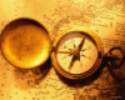Learning Objectives
- Students will recognize the four basic department goals.
- Students will visit the career center and demonstrate a basic familiarity with its resources.
- Students will recognize the various professional and student organizations useful to career development.
PART A: WHAT YOU SHOULD KNOW AND WHAT YOU SHOULD BE ABLE TO DO WHEN YOU GRADUATE
Included in the mission statement for the the geography department at CSUN are four basic goals. The program and the courses that constitute the program are designed to assist each student in realizing these goals.
Goal 1: Students will be an knowledgeable individuals.
This goal is related to the storehouse of facts that you have readily at your disposal. All geography majors, indeed all educated persons, should have at their disposal a useable store of knowledge about places, events and persons. These facts can be likened to the bricks with which you may build a house. Geographers frequently have a very large storehouse of these bricks, which has created some confusion over the years. Perhaps the most annoying things about being a geographer is that people, even those who ought to know better, frequently believe that professional geographers simply have an encyclopedic knowledge of the places around the world. You'll get sick of hearing, "Oh you're a geographer. I hated that in school. How can you remember all those countries and capitals" or "I bet you're good at Jeopardy". This is a product of generations of a misguided American educational system-public and private.
STILL, knowing many facts is an important part of being a geographer, because it gives allows you to leverage more important concepts, theories and ideas.
Goal 2: Students will be skilled learners.
Far more important than having a great knowledge base are the skills necessary to gain more knowledge. Following the construction analogy introduced above, goal two involves students learning to make their own bricks. To that end you should learn how to "learn as a geographer learns". This sounds silly, but in truth geographers have different learning skills than others. Like most others, geographers are textually literate, but in addition geographers should be graphically literate (graphicate) as well, which means should be able to read and interpret non-text communication media such as maps, tables and graphs. You should also have landscape literacy as well. This means you ought to be able to "read" and interpret the natural and built landscapes. Finally, you should know where to find and how to use common sources of information useful to geographers, how to navigate libraries, data warehouses and computer databases.
Goal 3: Students will be effective problem solvers.
Perhaps the most important skill you should acquire as a geography major is how to use your spatial thinking skills to frame questions and solve problems. In keeping with the construction analogy, you should not only have bricks and know how to make bricks, you should also be able to use them to build something useful. There are a great number of problem solving strategies that you will be introduced to before you graduate. Some are rooted in science and statistics, other in the humanities and still others are social scientific. Although these problem solving strategies often have commonalities with other disciplinary techniques, only geographers consistently privilege the question of "where?" as we go about answering the "why?" questions that drive our curiosity.
The topics geographers study are many of the same that fascinate historians, geologists, biologists, political scientists, sociologists, anthropologists, business people and other scholars, but we approach the same questions from a spatial perspective.
An emphasis on location as a causal variable is a primary indicator of spatial thinking and in the end that is the main skill or disposition, that you should have aquired when you graduate from this program. I talked to professional geographer last week (Jan 06') and he said he saved a school district many thousands of dollars. Apparently the school district was preparing to launch system-wide reforms, but after asking "where is the problem", they found out that the problems wasn't system-wide but endemic to a certain neighborhood. I have done research on predatory lending that consistently amazes consumer activists who research the same businesses. I have been able to demonstrate questionable business practices by payday lenders by answering the question "where are they". I hear the same comment all the time: "We never thought to map this data".
Goal 4: Students will be effective communicators.
And the last thing you should be able to do when you leave this program is to effectively communicate what you know using the communicative media used by geographers. Geographers should be good writers and speakers as a matter of course, but competent geographers should be able to communicate ideas through numbers and statistics; maps and graphs. The ability to communicate (read and write so to speak) with graphs and maps is called "graphicy".



